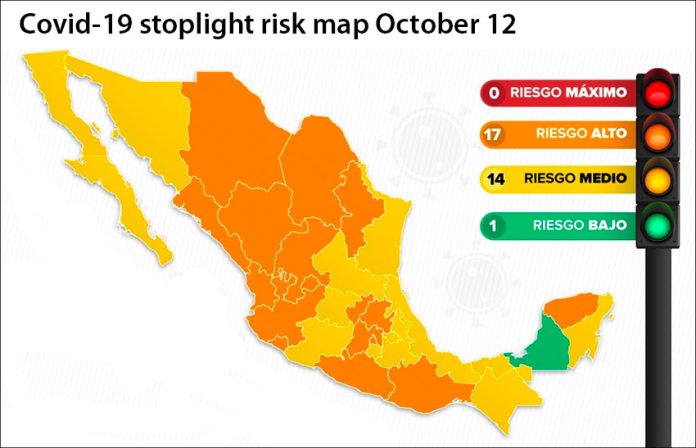Seven states will regress to orange light “high risk” from yellow light “medium” on Monday according to the federal government’s stoplight system to assess the risk of coronavirus infection, while five states will move the other way.
The Health Ministry announced Friday that Chihuahua, Coahuila, Sinaloa, Durango, Aguascalientes, Querétaro and Oaxaca will switch to the higher risk level next week.
As of Monday there will be 17 orange light states, an increase of two compared to the current number.
Ten states will remain at the orange light level for another two weeks. They are Nuevo León, Zacatecas, Nayarit, Jalisco, Colima, Hidalgo, Guerrero, Mexico City, México state and Yucatán.
The five states where the coronavirus risk level will be reduced to yellow from orange on Monday are San Luis Potosí, Veracruz, Michoacán, Baja California Sur and Quintana Roo.
They will join nine states that are currently yellow and will remain at the same risk level for the next two weeks. They are Tamaulipas, Puebla, Tlaxcala, Morelos, Guanajuato, Sonora, Baja California, Chiapas and Tabasco.
Campeche, which switched to the “low risk” level two weeks ago, will remain green for at least another two weeks.
The Health Ministry uses 10 different indicators to determine the stoplight color allocated to each state including the Covid-19 effective reproduction rate (how many people each infected person infects), the weekly positivity rate (the percentage of Covid-19 tests that come back positive) and hospital occupancy levels.
It also recommends coronavirus restrictions for each risk level but several states ease and tighten rules according to their own criteria rather than that of the federal government.
Presenting the updated risk levels at the coronavirus press briefing on Friday night, health promotion chief Ricardo Cortés urged state governments not to drop their guard in the fight against Covid-19.
He stressed that the infection risk level within a state can differ even though it is allocated a single stoplight color on the federal government map.
“Our national epidemic is made up of 32 local epidemics and each one of these local or state epidemics is made up of various municipal epidemics. Even within each municipality there can be different areas, different neighborhoods, different postal codes [with different risk levels],” Cortés said.
Earlier in the press briefing, Director of Epidemiology José Luis Alomía reported that Mexico’s accumulated coronavirus case tally had risen to 809,571, an increase of 5,263 cases compared to Thursday. The official Covid-19 death toll rose to 83,507 with 411 additional fatalities.
Alomía said that after nine consecutive weeks of declines in new estimated case numbers, infections increased 1% in epidemiological week 39 – September 20 to 26 – compared to the previous week.
Deputy Health Minister Hugo López-Gatell, Mexico’s coronavirus czar, reiterated that it is probable that there will be a new wave of coronavirus infections during the flu season.
“This situation is not occurring yet,” he said, adding that if and when there is a new wave of infections, the government will be forthright about it.
“The conviction of this government [is that] when things are going well they are communicated and when things aren’t going well they are communicated.”
Source: Reforma (sp), Milenio (sp), Forbes México (sp)
